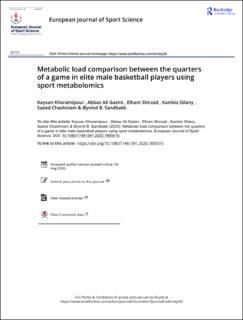Metabolic load comparison between the quarters of a game in elite male basketball players using sport metabolomics
Khoramipour, Kayvan; Gaeini, Abbbas Ali; Shirzad, Elham; Gilany, Kambiz; Chashniam, Saeed; Sandbakk, Øyvind
Peer reviewed, Journal article
Accepted version
Permanent lenke
https://hdl.handle.net/11250/2724221Utgivelsesdato
2020Metadata
Vis full innførselSamlinger
Originalversjon
10.1080/17461391.2020.1805515Sammendrag
Purpose: A basketball match is characterized by intermittent high-intensity activities, thereby relying extensively on both aerobic and anaerobic metabolic pathways. Here, we aimed to compare the metabolic fluctuations between the four 10-min quarters of high-level basketball games using metabolomics analyses. Methods: 70 male basketball players with at least 3 years of experience in the Iran national top-league participated. Before and after each quarter, saliva samples were taken for subsequent untargeted metabolomics analyses, where Principal component analysis (PCA) and Partial least squares-discriminant analysis (PLS-DA) were employed for statistical analysis. Results: Quarters 1 and 3 showed similar metabolic profiles, with increased levels of ATP turnover (higher Lactate, Pyruvate, Succinic Acid, Citric Cid, Glucose and Hypoxanthine), indicating more reliance on anaerobic energy systems than quarters 2 and 4. In comparison, quarters 2 and 4 showed a reduction in Valine and Lucien and an increase in Alanine, Glycerol, AcetoAcetic Acid, Acetone, Succinic Acid, Citric Acid, Acetate and Taurine that was not present in quarters 1 and 3, indicating greater reliance of aerobic energy contribution, fat metabolism and gluconeogenesis. Conclusion: Our data demonstrate that the higher intensity of movements in the first quarter, where players are more rested, induce an increase in anaerobic energy contribution. This seems to be the case also for the third quarter that follows 15 min of rest, whereas the accumulated fatigue and reduction of high-intensity movements in the second and fourth quarters also reduces the speed of energy production and players thereby utilize more aerobic energy.
